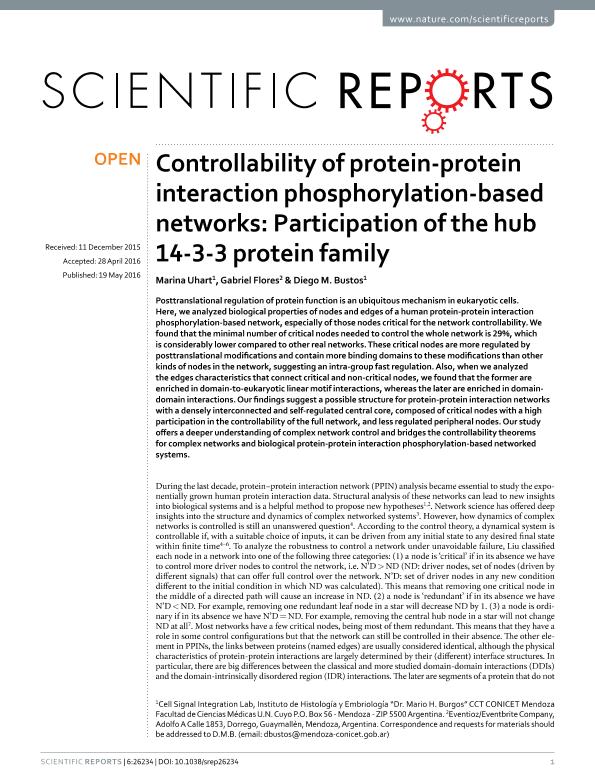Mostrar el registro sencillo del ítem
dc.contributor.author
Uhart, Marina

dc.contributor.author
Flores, Gabriel
dc.contributor.author
Bustos, Diego Martin

dc.date.available
2018-06-19T19:01:30Z
dc.date.issued
2016-05
dc.identifier.citation
Uhart, Marina; Flores, Gabriel; Bustos, Diego Martin; Controllability of protein-protein interaction phosphorylation-based networks: Participation of the hub 14-3-3 protein family; Nature Publishing Group; Scientific Reports; 6; 5-2016; 1-11
dc.identifier.issn
2045-2322
dc.identifier.uri
http://hdl.handle.net/11336/49387
dc.description.abstract
Posttranslational regulation of protein function is an ubiquitous mechanism in eukaryotic cells. Here, we analyzed biological properties of nodes and edges of a human protein-protein interaction phosphorylation-based network, especially of those nodes critical for the network controllability. We found that the minimal number of critical nodes needed to control the whole network is 29%, which is considerably lower compared to other real networks. These critical nodes are more regulated by posttranslational modifications and contain more binding domains to these modifications than other kinds of nodes in the network, suggesting an intra-group fast regulation. Also, when we analyzed the edges characteristics that connect critical and non-critical nodes, we found that the former are enriched in domain-to-eukaryotic linear motif interactions, whereas the later are enriched in domain-domain interactions. Our findings suggest a possible structure for protein-protein interaction networks with a densely interconnected and self-regulated central core, composed of critical nodes with a high participation in the controllability of the full network, and less regulated peripheral nodes. Our study offers a deeper understanding of complex network control and bridges the controllability theorems for complex networks and biological protein-protein interaction phosphorylation-based networked systems.
dc.format
application/pdf
dc.language.iso
eng
dc.publisher
Nature Publishing Group

dc.rights
info:eu-repo/semantics/openAccess
dc.rights.uri
https://creativecommons.org/licenses/by-nc-sa/2.5/ar/
dc.subject
14-3-3
dc.subject
Networks
dc.subject
Controlability
dc.subject.classification
Otras Ciencias Biológicas

dc.subject.classification
Ciencias Biológicas

dc.subject.classification
CIENCIAS NATURALES Y EXACTAS

dc.title
Controllability of protein-protein interaction phosphorylation-based networks: Participation of the hub 14-3-3 protein family
dc.type
info:eu-repo/semantics/article
dc.type
info:ar-repo/semantics/artículo
dc.type
info:eu-repo/semantics/publishedVersion
dc.date.updated
2018-06-13T16:53:51Z
dc.journal.volume
6
dc.journal.pagination
1-11
dc.journal.pais
Reino Unido

dc.journal.ciudad
Londres
dc.description.fil
Fil: Uhart, Marina. Consejo Nacional de Investigaciones Científicas y Técnicas. Centro Científico Tecnológico Conicet - Mendoza. Instituto de Histología y Embriología de Mendoza Dr. Mario H. Burgos. Universidad Nacional de Cuyo. Facultad de Cienicas Médicas. Instituto de Histología y Embriología de Mendoza Dr. Mario H. Burgos; Argentina
dc.description.fil
Fil: Flores, Gabriel. Eventioz/eventbrite Company; Argentina
dc.description.fil
Fil: Bustos, Diego Martin. Consejo Nacional de Investigaciones Científicas y Técnicas. Centro Científico Tecnológico Conicet - Mendoza. Instituto de Histología y Embriología de Mendoza Dr. Mario H. Burgos. Universidad Nacional de Cuyo. Facultad de Cienicas Médicas. Instituto de Histología y Embriología de Mendoza Dr. Mario H. Burgos; Argentina
dc.journal.title
Scientific Reports
dc.relation.alternativeid
info:eu-repo/semantics/altIdentifier/url/http://www.nature.com/articles/srep26234
dc.relation.alternativeid
info:eu-repo/semantics/altIdentifier/doi/http://dx.doi.org/10.1038/srep26234
Archivos asociados
